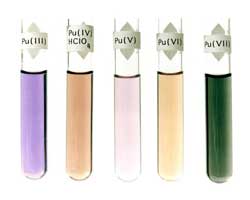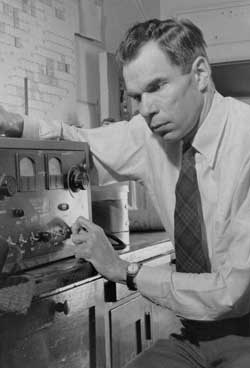Landmarks: The Physical Review’s Explosive Secret

APS has put the entire Physical Review archive online, back to 1893. Focus Landmarks feature important papers from the archive.
In the early days of World War II, physicists around the world were intently watching the pages of the Physical Review, waiting for updates on one of the century’s greatest revelations: fission, the splitting of an atom’s nucleus accompanied by a prodigious release of energy. But they waited in vain. Because of fears that Germany would use American research to pursue an atomic weapon, the Physical Review agreed to withhold reports of significant advances. It was not until several months after an atomic bomb exploded over Nagasaki, Japan, that Phys. Rev. published the paper announcing the discovery of plutonium, the material used in that bomb. Physicist Abraham Pais later called the journal’s silence on the subject “the most important nonevent in the history of the Physical Review.”
In 1940 the Physical Review published the discovery of element 93, the first element in the periodic table beyond the fissionable element uranium [1]. Although neptunium–named after Uranus’s neighbor–was not useful for a bomb, nearly all publication on fission-related work ceased shortly thereafter because of security concerns. The Physical Review and hundreds of other scientific journals agreed to submit all articles on the topic to a government committee.

But scientific investigations continued. During the winter of 1940-41, Glenn Seaborg and his colleagues at the University of California used the Berkeley cyclotron to bombard uranium oxide with deuterons–bullets made of a proton and a neutron. The bombardment turned uranium-238 into neptunium-238 by replacing a neutron with a proton. Some of the neptunium then decayed to the new element 94 by releasing a beta particle (an electron emitted by the nucleus), turning another neutron into a proton.
But the researchers were not sure of all this at first. In their first letter to Phys. Rev., submitted in January 1941, they reported that their sample emitted alpha-particles–helium nuclei consisting of two protons and two neutrons. They hypothesized that element 94 had appeared in the sample and was alpha-decaying back to uranium (element 92). But it was not until they performed more chemical analyses that they could be sure. They submitted the evidence in a second letter in March. Seaborg and his colleagues named the new element plutonium, after the final planet beyond Neptune.
Then Seaborg’s team collaborated with Berkeley colleague Emilio Segrè to create the isotope plutonium-239 by hitting a uranium-238 compound with neutrons. Unlike plutonium-238, the new isotope would make an excellent bomb material, the researchers told the government in a secret report, because it could be split by neutrons, and at a rate 50 percent faster than uranium-235. It also could be produced from the abundant isotope uranium-238, whereas uranium-235 was rare. They reported the fission results to Phys. Rev. in May 1941.
A year later, the government put Seaborg in charge of a large effort to develop a means of mass-producing plutonium for the Manhattan Project. He succeeded, and a plutonium bomb hit Nagasaki on August 9, 1945, just three days after a uranium bomb devastated Hiroshima.
In 1946 Phys. Rev. finally published Seaborg’s letters, and others, along with their original dates of submission and footnotes explaining that they were “withheld from publication until the end of the war.” In 1951, Seaborg won the Nobel Prize in Chemistry, in large part for his role in the discovery of plutonium.
In the end, the absence of publications on fission in the Physical Review was too glaring to go unnoticed. A Soviet scientist deduced from the Americans’ silence on the topic that they were pursuing an atomic bomb. The Soviets soon followed suit. Maurice Goldhaber, who withheld his own research on fission until after the war, took a lesson from the experience. “When you tell people not to think about it,” he says, “they’ll just do it.”
–Chelsea Wald
In 2006 Chelsea Wald was a science writing intern at APS. Now she is a freelance science writer in the Netherlands and the author of Pipe Dreams: The Urgent Global Quest to Transform the Toilet (Simon & Schuster, 2021).
References
- E. McMillan and P. H. Abelson, Phys. Rev. 57, 1185 (1940)


